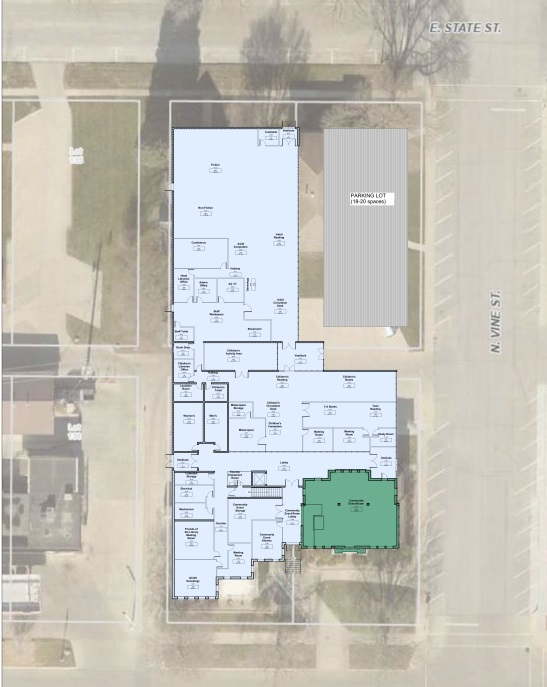The Jefferson public library board of trustees will recommend to the Jefferson city council that the city pursue construction of a one-story, 24,000 square-foot addition to the existing library. Estimated cost is $9.7 million.
The recommendation is the result of a year-long feasibility study conducted by a committee composed of community members, elected officials, and city/library staff, with Franks Design Group of Glenwood providing professional services.
The findings of the feasibility study were presented Oct. 4. Library director Jane Millard and Pete Franks of Franks Design Group spoke.
The study was funded by Grow Greene County.
It followed a needs assessment conducted by professional library space planner George Lawson in 2018. Lawson recommended that the Jefferson public library expand to prepare for growth and user trends in library services. He found the current library is “significantly too small to meet the community’s existing and future needs,” and recommended forming a committee to conduct a feasibility study of what the city needs and what could be done with the current building.
The library currently has slightly more than 8,000 square-feet, including the 1903 two-story Carnegie portion and the 1966 addition. Lawson estimated the total space requirement to be 23,000 square-feet. (For comparison, the Jefferson HyVee is 32,000 square feet.)
The feasibility study committee was tasked with looking at three options: razing the 1966 addition and putting a two-story structure with a basement in that space (Option A); acquiring ground and building an entirely new “from scratch” library (Option B); or acquiring an existing building and repurposing it as a library (Option C). The goal was to plan for a library that would serve the library needs of Jefferson residents for the next 75 years.
Option A did not include a large, public meeting room, something the committee determined was essential to the project.
Option B was the most economical, but that didn’t include the cost of purchasing land, and whether infrastructure like water and sewer lines would be needed. Also, a location in the central portion of the city was deemed to be important. A half-block space would be required.
Franks looked at repurposing the former Wells Fargo bank as a library as Option C. That building would need a 10,000 square-foot addition to be large enough, and the existing building doesn’t meet the specifications of a library. “It was designed to be a bank or an office building, and that’s very different than a library use,” Franks said. “On the surface… you could build a library in there, but once we started to dig a little deeper, we started to see a lot of mismatches. It just didn’t seem like a good fit.”
That exhausted the three options.

A fourth option, Option D was added, including parts of Options A and B. The 1903 Carnegie library would be used as a community meeting room, with an elevator added for easier access to the basement. The meeting area would be designed so it could be open to the public outside of regular library hours, greatly increasing its usability.
The plan Franks developed as Option D, which was one story, would be wrapped around the Carnegie building, primarily to the north and northwest of the current library. The properties of Complete Insurance and 203 W. State St would need to be acquired for the project. The 1966 addition would be razed.
The fourth option was the one recommended to the library trustees, who in turn will recommend it to the city council.
Franks provided estimated total project costs for all four options: Option A, $10.4 million; Option B, $8.8 million not including the cost of the site; Option C, $9.7 million; and Option D, $9.7 million.
The estimates are based on what’s expected in 2024, based on historic 5 percent inflation annually. Franks called this “a very precarious time” to predict project costs.
According to Franks, four to six years to complete this type of project is typical, but five to six years is more likely if a capital campaign is done for funding.
Library board of trustees president Susan Laehn said the board would likely model their efforts after the fundraising work of the Greene County Early Learning Center (now The Children’s Center) board. She said they would consider hiring a fundraising consultant. She added that some libraries have completed similar construction projects without seeking a bond issue.
The library trustees, along with Laehn, are secretary Mary Jane Fields, Jane Martino, Mike Piepel, Hollie Roberts, Tom Yepsen and Adam Pedersen. The late Jerry Roberts was on the board when the feasibility study began.
Serving on the architectural feasibility study committee were Connie Boyd, Carole Custer, Cindy Daubendiek, Traci Deal, Craig Hertel, Amy Milligan, Kate Neese, Mary Pedersen, Nancy Teusch, Allee Hinote, Gavin Vander Linden, Jefferson building/zoning officer Chad Stevens, city council members Darren Jackson and Matt Wetrich, Jefferson Matters: A Main Street and Chamber Community director Beth Vander Wilt, Friends of the Library board member Ginny Showman, library director Jane Millard and library staff members Jo Byriel and Stephanie Hall.
